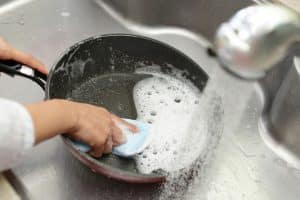How to wash a toilet cistern naturally? What are the best bathroom cleaners as an affordable and eco-friendly alternative? How to use homemade and ecological tank cleaners?
If you usually take care of cleaning the bathroom, you probably overlook this area. But washing a toilet cistern is really easy, even when you want to preserve the environment.
Next you will discover how to clean the toilet cistern in a natural, homemade and ecological way.
While using a pressure washer, brushes, soap and biodegradable disinfectants, you can also use some certified excellent quality products to wash and sanitize, such as food grade "Swipool".
Your other option is to hire a company specialized in the cistern washing, which guarantees the cleanliness of your cistern through the use of biodegradable and certified products to remove the water with pumps, pressure washing and a specialized tool to make repairs, change filters, inspection of cracks or fissures in the tanks, etc.
How often should I clean my toilet cistern?
Professional plumbers recommend cleaning the toilet cistern at least twice a year. This is the amount necessary to eliminate mold and bacteria, while refreshing the smell of your bathroom.
Washing a toilet cistern will not only prevent unpleasant odors from flooding your bathroom, but it is also the best way to extend the life of your toilet.
Why choose a natural tank cleaner?
If you want to reduce the use of chemicals for cleaning your home, then a natural cleaner is the perfect choice for washing a cistern.
These cleaners are easy to prepare at home, since you only need ingredients that are normally available in all houses. Plus, with the same (or even better) results than commercial toilet tank cleaners.
How to wash a toilet cistern naturally
Use a toilet brush
With a toilet brush you can thoroughly clean your toilet as well as the cistern under the flush button. Be sure to use a brush with a long, narrow handle, medium to firm bristles, and a shape that makes it easy to clean corners and tight spaces.
Follow these steps to successfully clean your cistern with a brush. With this method you can eliminate rust stains and mineral deposits that are easy to remove, without using harsh or dangerous chemicals.
- 1 long-handled toilet brush
- 1 pair of rubber gloves
- 1 basin with warm water
First, drain all the water from the cistern, close the water valve near the wall behind the toilet. Then flush the cistern.
It is recommended to wear rubber gloves to protect yourself from germs and bacteria.
Dip the bath brush in clean warm water and scrub all areas inside the cistern, including the sides and bottom of the tank.
When you have dislodged all the hit and mineral clumps, rinse the cistern with clean water. Repeat until clean.
If during the process you detect signs of wear, now is the ideal time to do any type of replacement.
Use vinegar
Vinegar is one of the best natural cleaners for removing mold, rust, and hard mineral deposits. Recommended for removing discoloration, hardened mineral deposits, rust stains, and mildew.
Vinegar is a chemical-free product and a natural antibacterial. And surely you already have it at home! You only need:
- Vinegar
- 1 pair of rubber gloves
- 1 basin with water
- 1 toilet brush
First close the water valve and empty the cistern until it is completely drained. Wait for it to dry.
Now fill the cistern with vinegar to the level of the overflow valve. Let the vinegar work for about 12 hours. Then drain the vinegar by flushing the toilet.
Using a brush, scrub and clean all the work pieces in the cistern. When you're done, reopen the water valve to finish rinsing the cistern.
Use baking soda and vinegar
The combination of baking soda with vinegar is one of the best cleaning products you can find. This formula is ideal for removing hardened mineral deposits, mold and rust.
Vinegar is a very useful natural disinfectant for removing rust and hard minerals. The baking soda, meanwhile, helps the water in the cistern maintain the proper pH to keep the water soft and resistant to mold and mildew. The tea tree oil added to this mixture will also remove odors, leaving a fresh scent.
To do it, you need:
- 1 pair of rubber gloves
- 2 cups of vinegar
- 1 basin of warm water
- 1 cup of baking soda
- 1 teaspoon tea tree oil
Start by draining the toilet cistern. Then mix the tea tree oil with the vinegar in a spray bottle. Spray the mixture on the area where you can see mineral build-up and let it sit for about five minutes.
Now to finish washing a toilet cistern, sprinkle baking soda on the sprayed areas and drug the stains with a brush. Lastly, rinse with lukewarm water and repeat until the toilet is completely clean.



